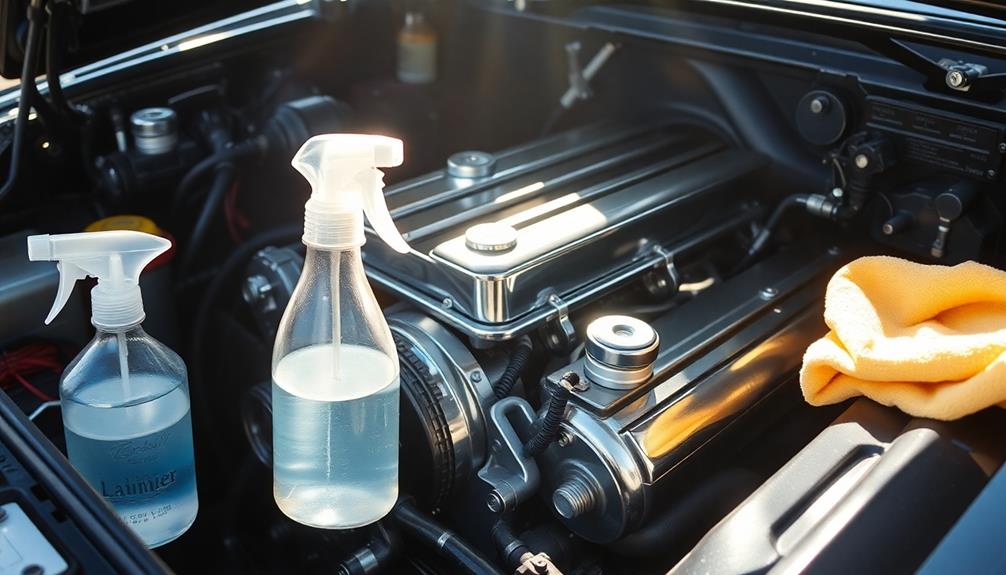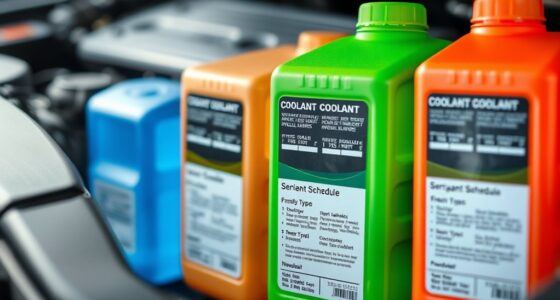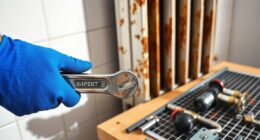You can transform your wiper blades' effectiveness with a simple $2 silicone cleaner! This affordable item not only removes dirt and grime but also restores the rubber's flexibility, improving contact with your windshield. With regular use, it enhances the performance of your wipers and makes sure your visibility stays clear, especially during harsh weather. Plus, incorporating this into your maintenance routine can save you money in the long run by extending the lifespan of your blades. Keep your driving safe and hassle-free, and find out more tips on how to maintain your wipers effectively!
Key Takeaways
- A $2 silicone wiper blade cleaner effectively removes dirt and grime, enhancing wiper performance and extending lifespan.
- Regular use of this cleaner restores rubber flexibility, ensuring better contact with the windshield.
- Incorporating the cleaner into your maintenance routine saves money on wiper replacements over time.
- Clean wiper blades improve visibility, reducing the risk of accidents during adverse weather conditions.
- Using this affordable item helps maintain wipers, allowing for clear driving without frequent replacements.
Why Wiper Blades Matter
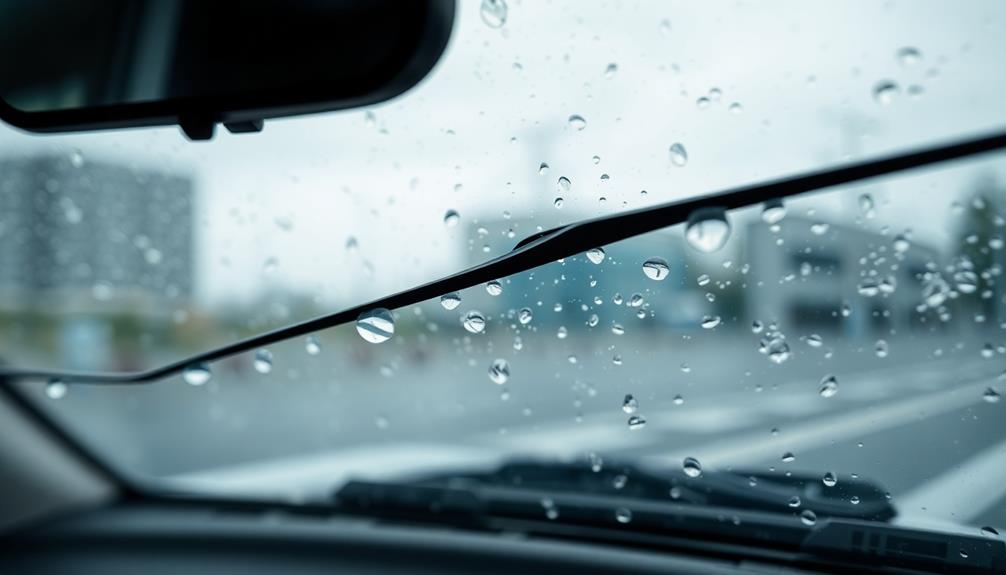
When it comes to driving safety, don't overlook the importance of wiper blades. These essential components play a vital role in maintaining clear visibility during adverse weather conditions.
If your wiper blades are neglected, you may notice streaks or smudges on your windshield, which can greatly impair your visibility and increase the risk of accidents. That's something you really need to watch!
According to your owner's manual, it's a good idea to replace your wiper blades approximately every six months. Doing so guarantees peak performance and safety while driving, especially during sudden weather changes.
Properly functioning wiper blades help you see clearly, allowing you to react quickly to any obstacles or hazards on the road.
Plus, regular inspections and maintenance of your wiper blades can save you from costly repairs down the line, as worn or ineffective blades can cause damage to your windshield.
Don't wait until the next storm to realize your wipers aren't up to the task. Take a few moments to check them now and make sure your driving experience remains safe and enjoyable.
How to Inspect Wiper Blades
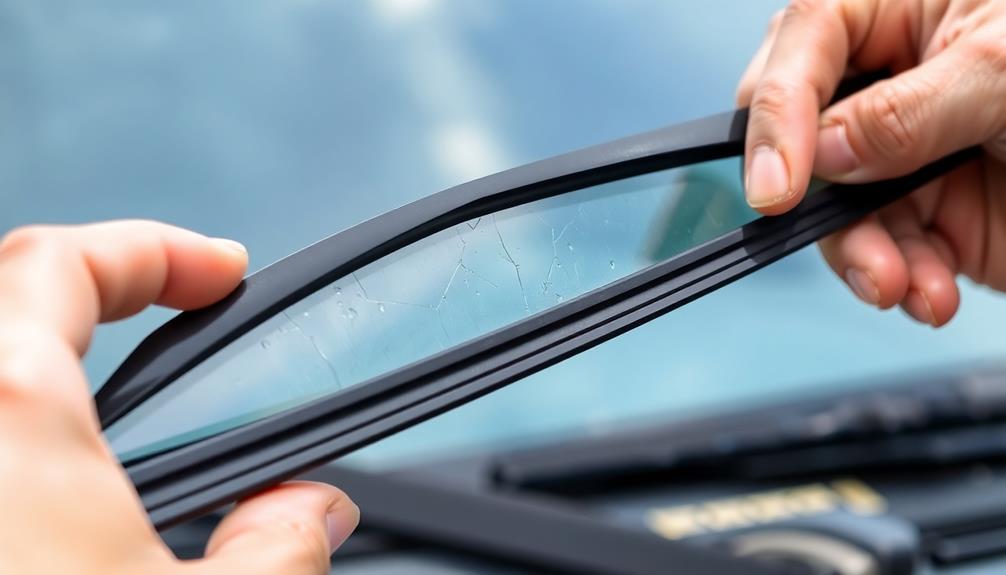
Inspecting your wiper blades regularly is essential for ensuring they function effectively. Start by utilizing the service position feature on your vehicle, which makes it easier to access the blades. As you inspect, make sure to check for smooth operation; they should move quietly and cover the entire windshield area.
Look for signs of wear, such as grooves, tears, or missing pieces on the rubber blade. These issues can greatly impair performance. Also, check for areas of the windshield that remain uncleaned after use, as this can indicate ineffective contact with the glass surface.
If the blades are dirty, clean them with glass cleaner. However, if you notice any damage, replacement is necessary to maintain visibility.
Here's a quick reference to help you with your inspection:
| Inspection Aspect | What to Look For | Action Needed |
|---|---|---|
| Blade Condition | Grooves, tears, or missing pieces | Replace if damaged |
| Operation | Smooth movement without noise | Adjust or replace if needed |
| Cleaning Effectiveness | Areas left uncleaned | Clean or replace as necessary |
Make sure to keep your wipers in top shape for safety!
Selecting the Right Wipers
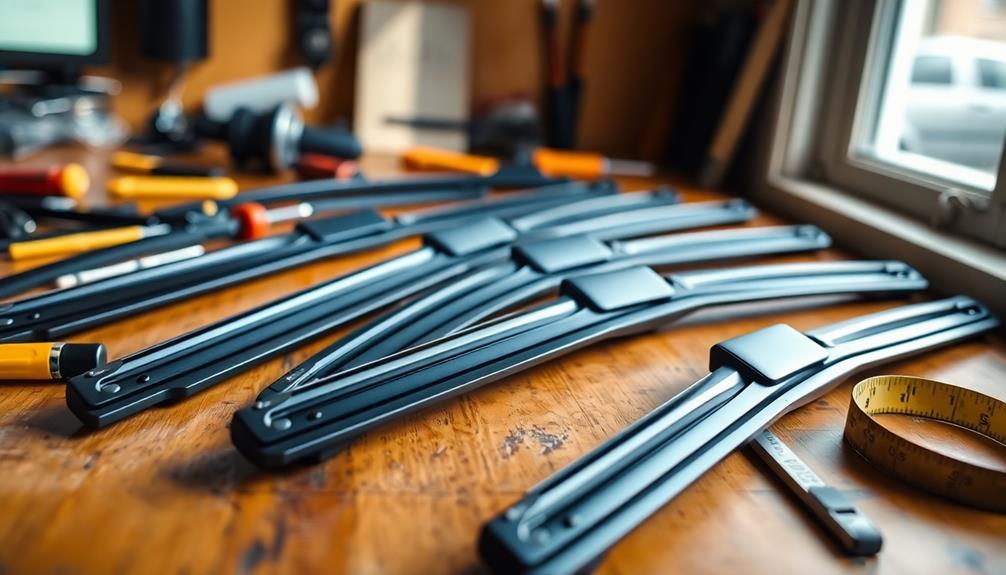
Choosing the right wiper blades is vital for maintaining clear visibility during inclement weather. First, make sure the wipers are compatible with your vehicle's make and model. This guarantees a proper fit and ideal performance.
Next, consider the curvature of your windshield. Some blades are specifically designed to contour to unique shapes, enhancing contact and cleaning efficiency.
If you can't find dealership-specific blades, look for universal fit options. Just be sure they meet the required specifications for your vehicle to avoid any issues.
Additionally, pay attention to the installation method; different wiper blades have various attachment styles. Ensuring a secure fit to your wiper arm is important for effective operation.
Before purchasing, always inspect the rubber blade for grooves or damage. Worn or missing pieces can drastically affect visibility and safety while driving.
Simple Maintenance Techniques
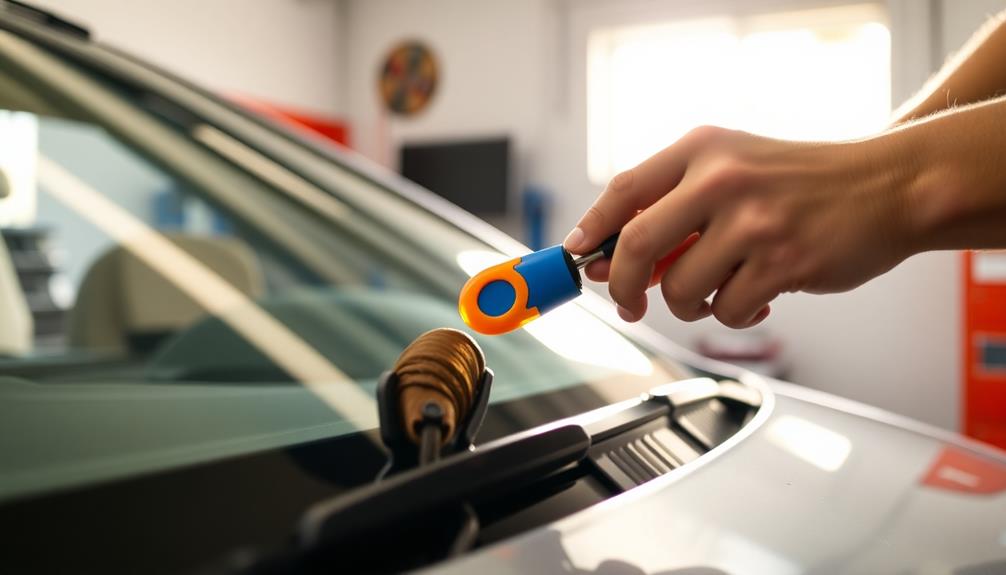
To keep your wipers in top shape, you should regularly inspect them for wear and tear every three months.
Engaging in regular maintenance not only enhances the life of your wipers but also contributes to a more organized vehicle environment, which can reduce stress levels during your drives.
Cleaning the blades with glass cleaner and topping off your windshield washer fluid will also boost their performance.
Plus, seasonal maintenance tips can help you avoid costly replacements while ensuring clear visibility in all weather conditions.
Consider implementing the art of decluttering strategies to maintain a tranquil and efficient driving experience.
Regular Blade Inspections
Regular inspections of your wiper blades are crucial for maintaining clear visibility, especially during adverse weather. Aim to conduct these inspections every three months to catch any wear or damage before they impact your safety.
During your checks, verify the blades operate smoothly and listen for any unusual noises. Pay attention to areas of your windshield that remain uncleaned—this can indicate a blade's ineffectiveness. Additionally, confirming that your vehicle's interior air quality is ideal can enhance your overall driving experience, making it easier to focus on the road and enjoy a clear view improved air quality.
Look closely for grooves, tears, or missing pieces on the rubber blade, as these issues can greatly impair performance and signal a need for replacement. A simple cleaning with glass cleaner can remove dirt and grime, extending the lifespan of your wipers and improving their functionality.
Additionally, keep your windshield washer fluid topped off and your windshield clean. This not only enhances visibility but also prevents rapid wear on your wiper blades.
Effective Cleaning Methods
Maintaining clean wiper blades is just as important as inspecting them for wear. Regular cleaning can greatly enhance their performance and extend their lifespan.
Here are three simple methods to keep your wipers in prime shape:
- Use Glass Cleaner: Spray a quality glass cleaner on your wiper blades to remove dirt and grime. This will help them glide smoothly across your windshield.
- Gentle Wipe: Grab a soft cloth or sponge and gently wipe the rubber part of the blades. Avoid harsh materials that can damage the rubber, which is essential for effective wiping.
- Keep the Windshield Clean: Regularly clean your windshield to eliminate debris and contaminants. A clean surface allows your wipers to operate more effectively, reducing wear and tear.
Additionally, don't forget to top off your windshield washer fluid. This guarantees ideal visibility and less strain on your wipers during operation.
Seasonal Maintenance Tips
When it comes to seasonal maintenance, it's vital to give your wiper blades some extra attention. Inspect your wiper blades every three months to spot any wear or damage that could compromise your visibility during rain or snow. If you notice any cracks or tears, it's time to replace them. Proper maintenance can enhance your overall driving experience, just as guaranteeing a clean campsite can elevate your time in nature unique camping experiences.
Cleaning your wiper blades regularly with glass cleaner can make a significant difference. This simple step removes dirt and grime, prolonging their lifespan and improving performance.
Don't forget to top off your windshield washer fluid regularly. This keeps your visibility ideal and guarantees your wipers can effectively clear away debris.
Maintaining a clean windshield is just as important. Dirt accumulation can wear out your wiper blades faster and cause streaks, reducing their effectiveness.
In winter months, use an ice scraper instead of your wipers to remove ice. Using wipers for this purpose can lead to damage and decreased performance.
Common Wiper Blade Mistakes

Ignoring wiper blade maintenance can lead to dangerous visibility issues and compromised safety on the road. Many drivers overlook their wipers until they notice streaks or smudges, but a quick inspection every three months can prevent potential hazards.
Here are some common mistakes to avoid:
- Believing All Wipers Are Universal: It's a misconception that wiper blades fit every vehicle. Always choose blades that match your car's make and model to guarantee peak performance.
- Neglecting Windshield Cleanliness: Dirt and grime buildup can drastically reduce wiper effectiveness, leading to streaking. Regularly clean your windshield to enhance visibility and prolong the life of your wipers.
- Replacing Blades Infrequently: Some drivers think wipers last forever, but you should replace them about every six months. This helps maintain safety and guarantees clear visibility during inclement weather.
The Essential Item
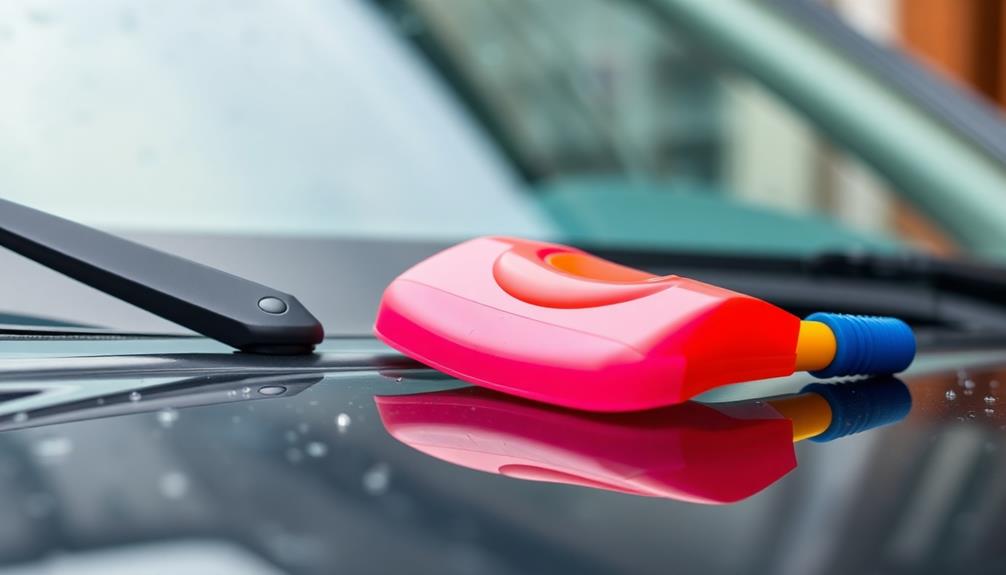
A simple $2 silicone wiper blade cleaner can be a game changer for your vehicle's maintenance routine. This affordable tool effectively extends the lifespan of your wiper blades by removing dirt and grime that diminishes their performance. By using this cleaner regularly, you can prevent the accumulation of debris that leads to streaking and reduced visibility.
One of the standout features of the silicone cleaner is its ability to restore the rubber's flexibility. This guarantees better contact with your windshield, resulting in peak performance when you need it most. Instead of constantly replacing your wiper blades, incorporating this quick and easy maintenance solution can save you money in the long run.
Additionally, utilizing a silicone cleaner enhances the effectiveness of your windshield washer fluid. This means clearer visibility during adverse weather conditions, giving you peace of mind while driving.
For just $2, you're investing in a simple yet effective way to keep your wipers in top shape. Make this essential item part of your vehicle care routine, and you'll never look back at your old wiper blade maintenance habits!
DIY Wiper Replacement Process
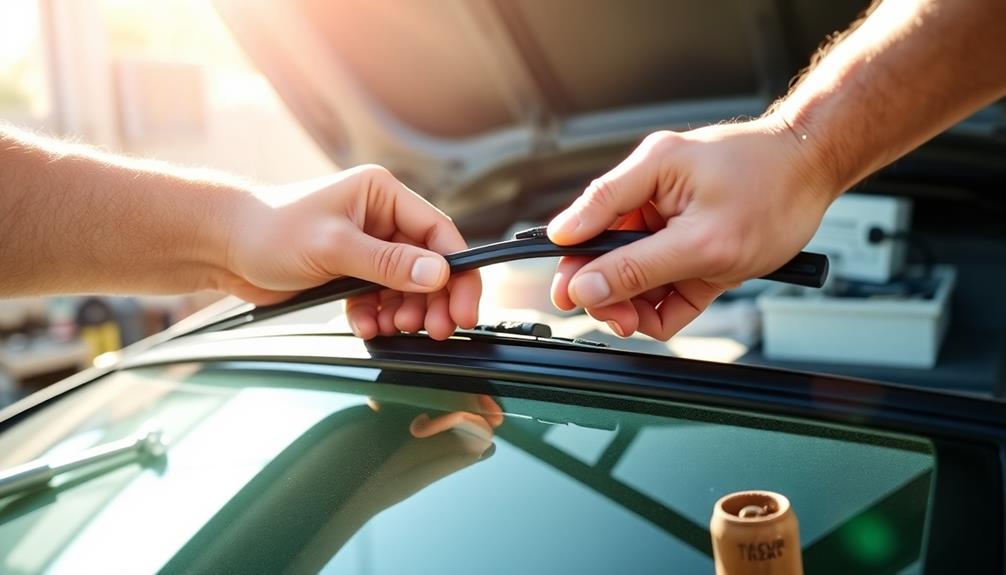
Keeping your wipers in top shape is only part of the equation; knowing how to replace them is equally important. Follow these simple steps to guarantee a smooth DIY wiper replacement process.
- Lift the Wiper Arm: Start by lifting the wiper arm away from the windshield. This gives you better access to the wiper blade.
- Remove the Old Blade: Locate the release tab on the old blade. Press it to detach the blade easily from the wiper arm.
- Attach the New Blade: Align the new wiper blade with the wiper arm. Push firmly until you hear a click, confirming it's securely attached.
Once you've replaced the blades, turn them on to test their performance. Verify they operate smoothly without any noise or skipping on the windshield.
It's also essential to dispose of the old wiper blades properly.
Remember to periodically inspect your new blades every few months for wear and tear. This simple maintenance guarantees your wipers will be reliable whenever you need them, keeping your view clear on the road ahead.
Benefits of Regular Wiper Care
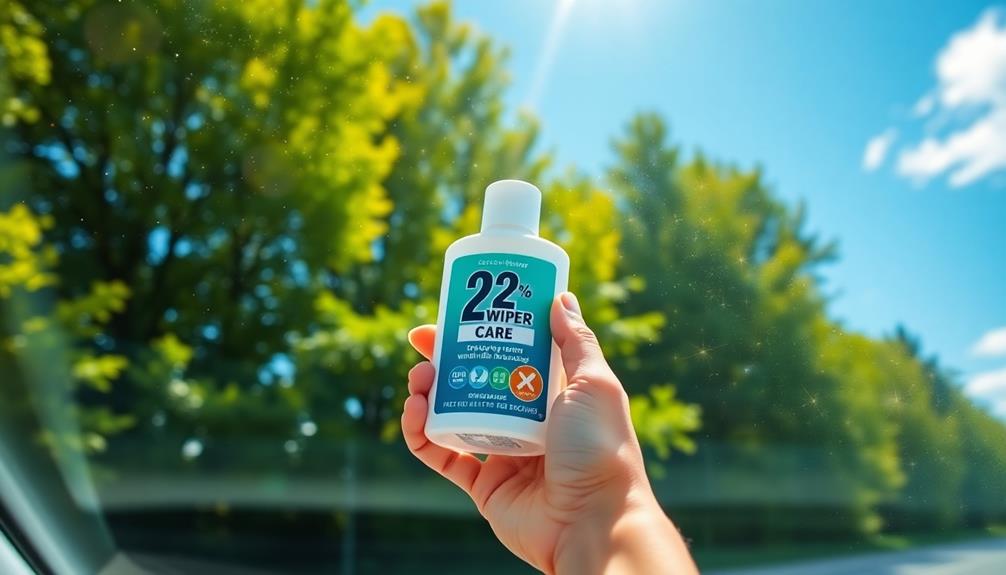
Taking care of your wipers isn't just about convenience; it's essential for your safety.
Regular maintenance boosts visibility during bad weather, helps you save money on costly repairs, and extends the lifespan of your wiper blades.
Enhanced Visibility Safety
When you neglect your wiper blades, you not only risk diminished visibility but also compromise your safety on the road.
Regular maintenance is essential for guaranteeing clear sightlines, especially during adverse weather conditions. Worn or damaged blades can leave streaks on your windshield, making it harder to see and increasing the risk of accidents.
To enhance your visibility and safety, consider these three vital maintenance tips:
- Inspect Regularly: Check your wiper blades every six months for signs of wear or damage. Replace them if you notice cracks, tears, or stiffness.
- Keep Clean: Regularly clean your wiper blades to remove dirt and debris. This simple step can greatly improve their performance and lifespan.
- Top Off Washer Fluid: Confirm your washer fluid reservoir is full. This helps maintain peak visibility by clearing away muck that blades alone might miss.
Cost-Effective Maintenance
Regular maintenance of your wiper blades not only enhances your driving experience but also saves you money in the long run. By changing your wiper blades every six months, you considerably improve visibility during rain or snow, reducing the risk of accidents and potential costs associated with mishaps.
Performing quarterly inspections helps you catch wear and damage early, preventing expensive windshield repairs that often stem from neglected blades.
Cleaning your wiper blades with glass cleaner is another simple step that can extend their lifespan. This keeps them operating smoothly without leaving streaks or uncleaned areas on your windshield.
Additionally, maintaining a clean windshield and keeping washer fluid topped off prevents rapid blade wear, ensuring peak performance when you need it most.
Instead of using your wipers to clear ice, use an ice scraper. This practice preserves the integrity and functionality of your wipers, contributing to more effective maintenance over time.
Extended Blade Lifespan
Maintaining your wiper blades not only boosts your driving safety but also greatly extends their lifespan. Regular care can help you avoid frequent replacements, saving you time and money.
Here are three key practices to keep your wipers in top shape:
- Inspect Every Three Months: Check for wear and damage regularly. Early detection can prevent safety hazards and guarantee clear visibility, especially during storms.
- Clean with Glass Cleaner: Wiper blades collect dirt and grime over time. Cleaning them helps maintain proper contact with the windshield, enhancing performance and extending their life.
- Use an Ice Scraper: When winter hits, opt for an ice scraper instead of using your wipers to clear ice. This simple switch prevents unnecessary wear and tear, ultimately prolonging your blades' life.
Don't forget to top off your windshield washer fluid consistently. Keeping your windshield clean reduces strain on wiper blades, minimizing rapid wear.
Also, consider replacing your wipers every six months to guarantee effective performance. By integrating these practices, you'll enjoy clearer visibility and a longer lifespan for your wiper blades!
Frequently Asked Questions
What Are the Different Types of Wiper Connectors?
You'll find several wiper connector types: hook, pin, bayonet, and flat. Each serves a specific purpose, ensuring your wiper blades attach securely for ideal performance. Choose the right one for your vehicle's needs!
Do Windshield Wipers Come With 2?
Think of your car as a knight; it needs two trusty swords—one for each side. Yes, most windshield wipers come with two blades, ensuring you've got the visibility needed to conquer any storm.
How to Change Windshield Wipers Step by Step?
To change your windshield wipers, lift the wiper arm, detach the old blade, align the new blade with the arm, secure it, and gently lower the arm. Test the wipers to verify they're working properly.
What Happens if You Don't Replace Windshield Wipers?
Did you know that 90% of accidents happen in wet conditions? If you don't replace your windshield wipers, you're risking poor visibility, streaks, and costly windshield damage, all of which can make driving dangerously treacherous.
Conclusion
By keeping your wipers in top shape, you're not just ensuring clear visibility; you're safeguarding every journey, like a knight in shining armor protecting your kingdom. With that $2 essential item, you can easily replace your wipers and enjoy the peace of mind that comes with driving in any weather. Don't let a simple oversight rain on your parade—embrace regular wiper care, and you'll never look back on those blurry days again!

